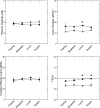Evidence for net renal tubule oxalate secretion in patients with calcium kidney stones
- PMID: 21123489
- PMCID: PMC3043999
- DOI: 10.1152/ajprenal.00411.2010
Evidence for net renal tubule oxalate secretion in patients with calcium kidney stones
Abstract
Little is known about the renal handling of oxalate in patients with idiopathic hypercalciuria (IH). To explore the role of tubular oxalate handling in IH and to evaluate whether differences exist between IH and normal controls, we studied 19 IH subjects, 8 normal subjects, and 2 bariatric stone formers (BSF) during a 1-day General Clinical Research Center protocol utilizing a low-oxalate diet. Urine and blood samples were collected at 30- to 60-min intervals while subjects were fasting and after they ate three meals providing known amounts of calcium, phosphorus, sodium, protein, oxalate, and calories. Plasma oxalate concentrations and oxalate-filtered loads were similar between patients (includes IH and BSF) and controls in both the fasting and fed states. Urinary oxalate excretion was significantly higher in patients vs. controls regardless of feeding state. Fractional excretion of oxalate (FEOx) was >1, suggesting tubular secretion of oxalate, in 6 of 19 IH and both BSF, compared with none of the controls (P < 0.00001). Adjusted for water extraction along the nephron, urine oxalate rose more rapidly among patients than normal subjects with increases in plasma oxalate. Our findings identify tubular secretion of oxalate as a key mediator of hyperoxaluria in calcium stone formers, potentially as a means of maintaining plasma oxalate in a tight range.
Figures




Comment in
-
Re.: Evidence for net renal tubule oxalate secretion in patients with calcium kidney stones.J Urol. 2011 May;185(5):1747. doi: 10.1016/j.juro.2011.01.049. Epub 2011 Mar 21. J Urol. 2011. PMID: 22088705 No abstract available.
References
-
- Asplin JR, Coe FL. Hyperoxaluria in kidney stone formers treated with modern bariatric surgery.J Urol 177:565–569, 2007 - PubMed
-
- Baggio B, Gambaro G, Favaro S, Borsatti A. Prevalence of hyperoxaluria in idiopathic calcium oxalate kidney stone disease.Nephron 35:11–14, 1983 - PubMed
-
- Bergsland KJ, Coe FL, Gillen DL, Worcester EM. A test of the hypothesis that the collecting duct calcium-sensing receptor limits rise of urine calcium molarity in hypercalciuric calcium kidney stone formers.Am J Physiol Renal Physiol 297:F1017–F1023, 2009 - PMC - PubMed
-
- Coe FL, Parks JH, Evan AP, Worcester EM. Pathogenesis and treatment of nephrolithiasis.In: Seldin and Giebisch's The Kidney (4th ed.), edited by Alpern RJ, Hebert SC.Burlington, MA: Academic, 2008, p. 1945–1977
Publication types
MeSH terms
Substances
Grants and funding
LinkOut - more resources
Full Text Sources
Research Materials

